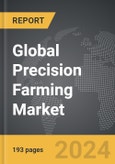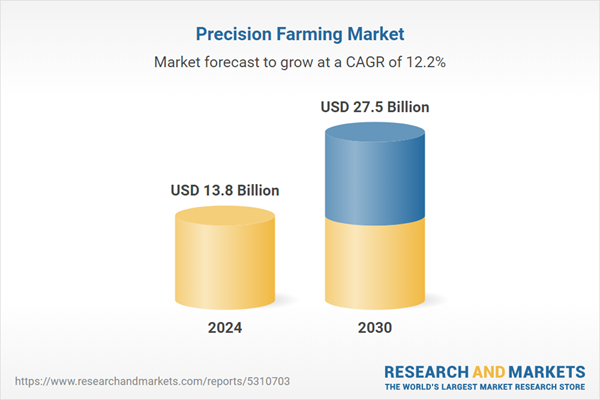The global market for Precision Farming was valued at US$13.8 Billion in 2024 and is projected to reach US$27.5 Billion by 2030, growing at a CAGR of 12.2% from 2024 to 2030. This comprehensive report provides an in-depth analysis of market trends, drivers, and forecasts, helping you make informed business decisions.
Global Precision Farming Market - Key Trends and Drivers Summarized
What Is Precision Farming and How Does It Work?
Precision farming, also known as precision agriculture, is a modern farming practice that utilizes advanced technology to enhance crop production efficiency and sustainability. This approach involves the use of GPS, sensors, drones, and data analytics to monitor and manage agricultural activities with remarkable accuracy. By collecting detailed information about soil conditions, weather patterns, crop health, and pest activity, precision farming allows farmers to make informed decisions that optimize input use and improve crop yields. For instance, GPS-guided machinery can apply fertilizers and pesticides with pinpoint accuracy, reducing waste and environmental impact. Drones equipped with multispectral cameras can assess crop health in real-time, enabling timely interventions. The integration of these technologies transforms traditional farming into a data-driven practice, where every decision is supported by precise, actionable insights.Why Is Precision Farming Gaining Popularity Among Farmers?
The growing popularity of precision farming among farmers can be attributed to its significant benefits in terms of productivity, cost savings, and sustainability. One of the key advantages is the ability to maximize resource use efficiency, which directly translates to reduced costs for seeds, fertilizers, water, and pesticides. By applying inputs only where and when they are needed, farmers can minimize waste and increase their return on investment. Precision farming also helps in mitigating the environmental impact of agriculture by reducing chemical runoff and preserving soil health. Moreover, the ability to monitor crop health continuously and detect issues early on enhances the resilience of farming operations against pests, diseases, and adverse weather conditions. This proactive approach not only safeguards crop yields but also improves the quality of produce. As a result, precision farming is becoming an essential tool for farmers aiming to enhance profitability while adhering to sustainable farming practices.How Are Technological Innovations Shaping Precision Farming?
Technological innovations are at the heart of precision farming, driving its evolution and expanding its capabilities. Developments in sensor technology have enabled the creation of sophisticated soil moisture and nutrient sensors that provide real-time data on soil conditions. These sensors can be integrated with irrigation systems to automate water delivery based on precise soil needs, significantly conserving water. Advances in satellite imagery and remote sensing technologies have also revolutionized precision farming, allowing for the monitoring of large agricultural areas from space with unprecedented detail and frequency. Additionally, machine learning algorithms and artificial intelligence are being employed to analyze vast amounts of agricultural data, offering predictive insights and automated decision-making tools that enhance farming efficiency. The advent of the Internet of Things (IoT) has further interconnected various farming equipment and systems, facilitating seamless data exchange and integrated farm management. These technological advancements are continuously pushing the boundaries of what precision farming can achieve, making it a rapidly evolving field with immense potential.What Factors Are Driving Growth in the Precision Farming Market?
The growth in the precision farming market is driven by several factors reflecting technological advancements, economic incentives, and evolving consumer and regulatory expectations. A significant driver is the increasing global demand for food, which necessitates higher agricultural productivity and efficiency. Technological advancements, such as the development of advanced sensors, drones, and data analytics tools, are making precision farming more accessible and effective, encouraging widespread adoption. The rising cost of agricultural inputs and the need to maximize resource use efficiency are also propelling the market, as precision farming offers a viable solution to reduce costs and enhance yields. Additionally, the growing awareness about the environmental impact of conventional farming practices is driving demand for sustainable agriculture solutions, where precision farming plays a crucial role. Government initiatives and subsidies supporting modern agricultural techniques and the integration of smart technologies in farming further boost market growth. Moreover, the increasing focus on food quality and safety, driven by consumer preferences and regulatory requirements, is fostering the adoption of precision farming practices that ensure traceability and high-quality produce. As these factors converge, the precision farming market is poised for robust growth, supported by continuous innovation and the global push for sustainable and efficient agricultural practices.Report Scope
The report analyzes the Precision Farming market, presented in terms of market value (US$ Thousand). The analysis covers the key segments and geographic regions outlined below.Segments
Offering (Hardware, Software, Services); Application (Yield Monitoring, Field Mapping, Crop Scouting, Farm labor Management, Irrigation Management, Other Applications).Geographic Regions/Countries
World; United States; Canada; Japan; China; Europe (France; Germany; Italy; United Kingdom; and Rest of Europe); Asia-Pacific; Rest of World.Key Insights:
- Market Growth: Understand the significant growth trajectory of the Precision Farming Hardware segment, which is expected to reach US$17.9 Billion by 2030 with a CAGR of a 11.5%. The Precision Farming Software segment is also set to grow at 14.0% CAGR over the analysis period.
- Regional Analysis: Gain insights into the U.S. market, valued at $3.8 Billion in 2024, and China, forecasted to grow at an impressive 11.6% CAGR to reach $4.3 Billion by 2030. Discover growth trends in other key regions, including Japan, Canada, Germany, and the Asia-Pacific.
Report Features:
- Comprehensive Market Data: Independent analysis of annual sales and market forecasts in US$ Million from 2024 to 2030.
- In-Depth Regional Analysis: Detailed insights into key markets, including the U.S., China, Japan, Canada, Europe, Asia-Pacific, Latin America, Middle East, and Africa.
- Company Profiles: Coverage of major players such as AG Leader, AGCO Corporation, AgEagle, AgJunction, Autocopter Corp and more.
- Complimentary Updates: Receive free report updates for one year to keep you informed of the latest market developments.
Why You Should Buy This Report:
- Detailed Market Analysis: Access a thorough analysis of the Global Precision Farming Market, covering all major geographic regions and market segments.
- Competitive Insights: Get an overview of the competitive landscape, including the market presence of major players across different geographies.
- Future Trends and Drivers: Understand the key trends and drivers shaping the future of the Global Precision Farming Market.
- Actionable Insights: Benefit from actionable insights that can help you identify new revenue opportunities and make strategic business decisions.
Key Questions Answered:
- How is the Global Precision Farming Market expected to evolve by 2030?
- What are the main drivers and restraints affecting the market?
- Which market segments will grow the most over the forecast period?
- How will market shares for different regions and segments change by 2030?
- Who are the leading players in the market, and what are their prospects?
Some of the 43 major companies featured in this Precision Farming market report include:
- AG Leader
- AGCO Corporation
- AgEagle
- AgJunction
- Autocopter Corp
- Autonomous Tractor Corporation
- CropX Technologies
- Deere & Company
- Descartes Labs
- ec2ce
- Granular
- Hexagon Agriculture
- Prospera Technologies
- Raven Industries
- Taranis
- Teejet Technologies
- The Climate Corporation
- Topcon Positioning Systems
- Trimble
Table of Contents
I. METHODOLOGYII. EXECUTIVE SUMMARY2. FOCUS ON SELECT PLAYERSIII. MARKET ANALYSISIV. COMPETITION
1. MARKET OVERVIEW
3. MARKET TRENDS & DRIVERS
4. GLOBAL MARKET PERSPECTIVE
UNITED STATES
CANADA
JAPAN
CHINA
EUROPE
FRANCE
GERMANY
ITALY
UNITED KINGDOM
REST OF EUROPE
ASIA-PACIFIC
REST OF WORLD
Companies Mentioned (Partial List)
A selection of companies mentioned in this report includes, but is not limited to:
- AG Leader
- AGCO Corporation
- AgEagle
- AgJunction
- Autocopter Corp
- Autonomous Tractor Corporation
- CropX Technologies
- Deere & Company
- Descartes Labs
- ec2ce
- Granular
- Hexagon Agriculture
- Prospera Technologies
- Raven Industries
- Taranis
- Teejet Technologies
- The Climate Corporation
- Topcon Positioning Systems
- Trimble
Table Information
| Report Attribute | Details |
|---|---|
| No. of Pages | 187 |
| Published | April 2025 |
| Forecast Period | 2024 - 2030 |
| Estimated Market Value ( USD | $ 13.8 Billion |
| Forecasted Market Value ( USD | $ 27.5 Billion |
| Compound Annual Growth Rate | 12.2% |
| Regions Covered | Global |









